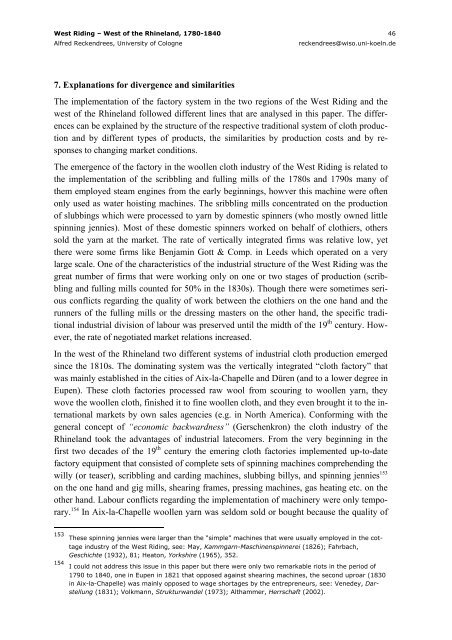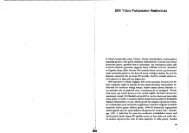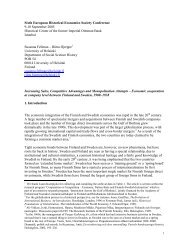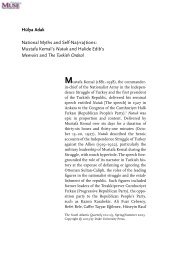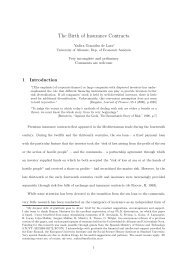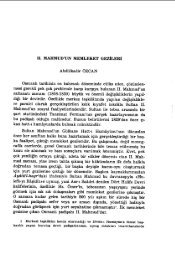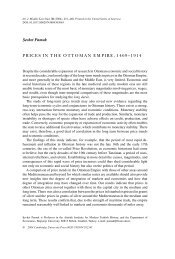West Riding – Western Rhineprovince, 1790-1840: Diverse Paths to ...
West Riding – Western Rhineprovince, 1790-1840: Diverse Paths to ...
West Riding – Western Rhineprovince, 1790-1840: Diverse Paths to ...
You also want an ePaper? Increase the reach of your titles
YUMPU automatically turns print PDFs into web optimized ePapers that Google loves.
<strong>West</strong> <strong>Riding</strong> <strong>–</strong> <strong>West</strong> of the Rhineland, 1780-<strong>1840</strong> 46<br />
Alfred Reckendrees, University of Cologne reckendrees@wiso.uni-koeln.de<br />
7. Explanations for divergence and similarities<br />
The implementation of the fac<strong>to</strong>ry system in the two regions of the <strong>West</strong> <strong>Riding</strong> and the<br />
west of the Rhineland followed different lines that are analysed in this paper. The differences<br />
can be explained by the structure of the respective traditional system of cloth production<br />
and by different types of products, the similarities by production costs and by responses<br />
<strong>to</strong> changing market conditions.<br />
The emergence of the fac<strong>to</strong>ry in the woollen cloth industry of the <strong>West</strong> <strong>Riding</strong> is related <strong>to</strong><br />
the implementation of the scribbling and fulling mills of the 1780s and <strong>1790</strong>s many of<br />
them employed steam engines from the early beginnings, howver this machine were often<br />
only used as water hoisting machines. The sribbling mills concentrated on the production<br />
of slubbings which were processed <strong>to</strong> yarn by domestic spinners (who mostly owned little<br />
spinning jennies). Most of these domestic spinners worked on behalf of clothiers, others<br />
sold the yarn at the market. The rate of vertically integrated firms was relative low, yet<br />
there were some firms like Benjamin Gott & Comp. in Leeds which operated on a very<br />
large scale. One of the characteristics of the industrial structure of the <strong>West</strong> <strong>Riding</strong> was the<br />
great number of firms that were working only on one or two stages of production (scribbling<br />
and fulling mills counted for 50% in the 1830s). Though there were sometimes serious<br />
conflicts regarding the quality of work between the clothiers on the one hand and the<br />
runners of the fulling mills or the dressing masters on the other hand, the specific traditional<br />
industrial division of labour was preserved until the midth of the 19 th century. However,<br />
the rate of negotiated market relations increased.<br />
In the west of the Rhineland two different systems of industrial cloth production emerged<br />
since the 1810s. The dominating system was the vertically integrated “cloth fac<strong>to</strong>ry” that<br />
was mainly established in the cities of Aix-la-Chapelle and Düren (and <strong>to</strong> a lower degree in<br />
Eupen). These cloth fac<strong>to</strong>ries processed raw wool from scouring <strong>to</strong> woollen yarn, they<br />
wove the woollen cloth, finished it <strong>to</strong> fine woollen cloth, and they even brought it <strong>to</strong> the international<br />
markets by own sales agencies (e.g. in North America). Conforming with the<br />
general concept of “economic backwardness” (Gerschenkron) the cloth industry of the<br />
Rhineland <strong>to</strong>ok the advantages of industrial latecomers. From the very beginning in the<br />
first two decades of the 19 th century the emering cloth fac<strong>to</strong>ries implemented up-<strong>to</strong>-date<br />
fac<strong>to</strong>ry equipment that consisted of complete sets of spinning machines comprehending the<br />
willy (or teaser), scribbling and carding machines, slubbing billys, and spinning jennies 153<br />
on the one hand and gig mills, shearing frames, pressing machines, gas heating etc. on the<br />
other hand. Labour conflicts regarding the implementation of machinery were only temporary.<br />
154 In Aix-la-Chapelle woollen yarn was seldom sold or bought because the quality of<br />
153<br />
These spinning jennies were larger than the “simple” machines that were usually employed in the cottage<br />
industry of the <strong>West</strong> <strong>Riding</strong>, see: May, Kammgarn-Maschinenspinnerei (1826); Fahrbach,<br />
Geschichte (1932), 81; Hea<strong>to</strong>n, Yorkshire (1965), 352.<br />
154<br />
I could not address this issue in this paper but there were only two remarkable riots in the period of<br />
<strong>1790</strong> <strong>to</strong> <strong>1840</strong>, one in Eupen in 1821 that opposed against shearing machines, the second uproar (1830<br />
in Aix-la-Chapelle) was mainly opposed <strong>to</strong> wage shortages by the entrepreneurs, see: Venedey, Darstellung<br />
(1831); Volkmann, Strukturwandel (1973); Althammer, Herrschaft (2002).


